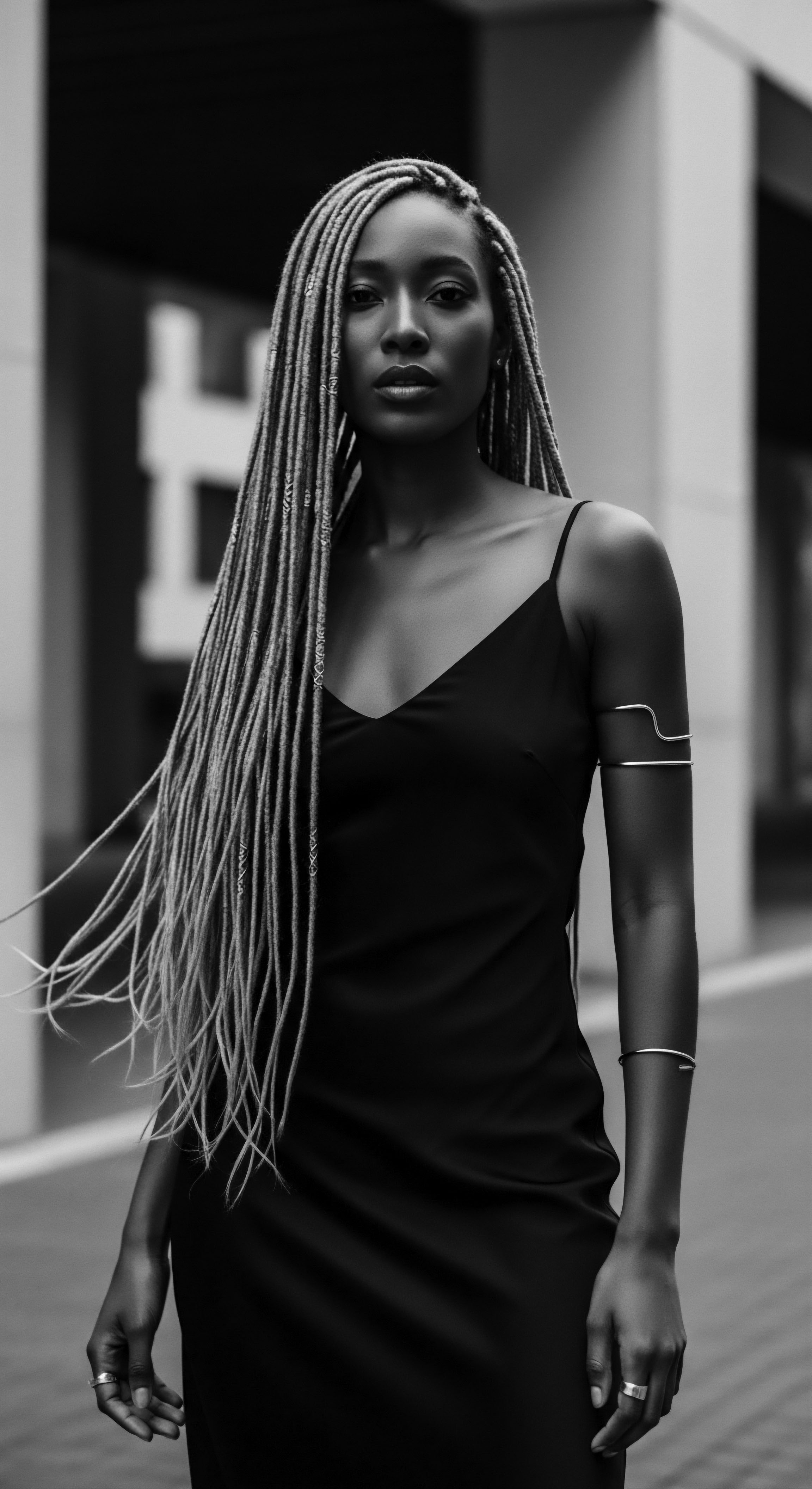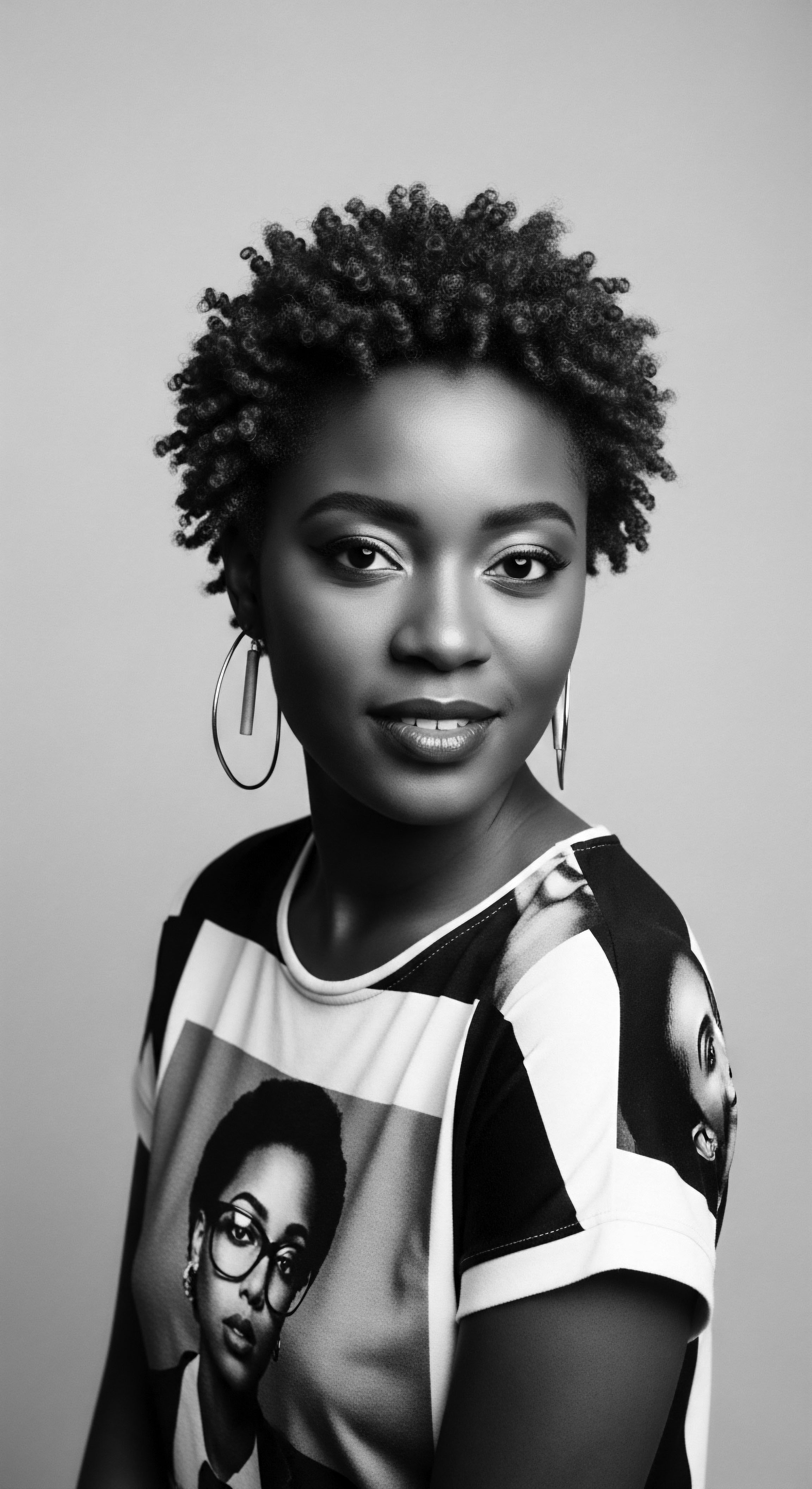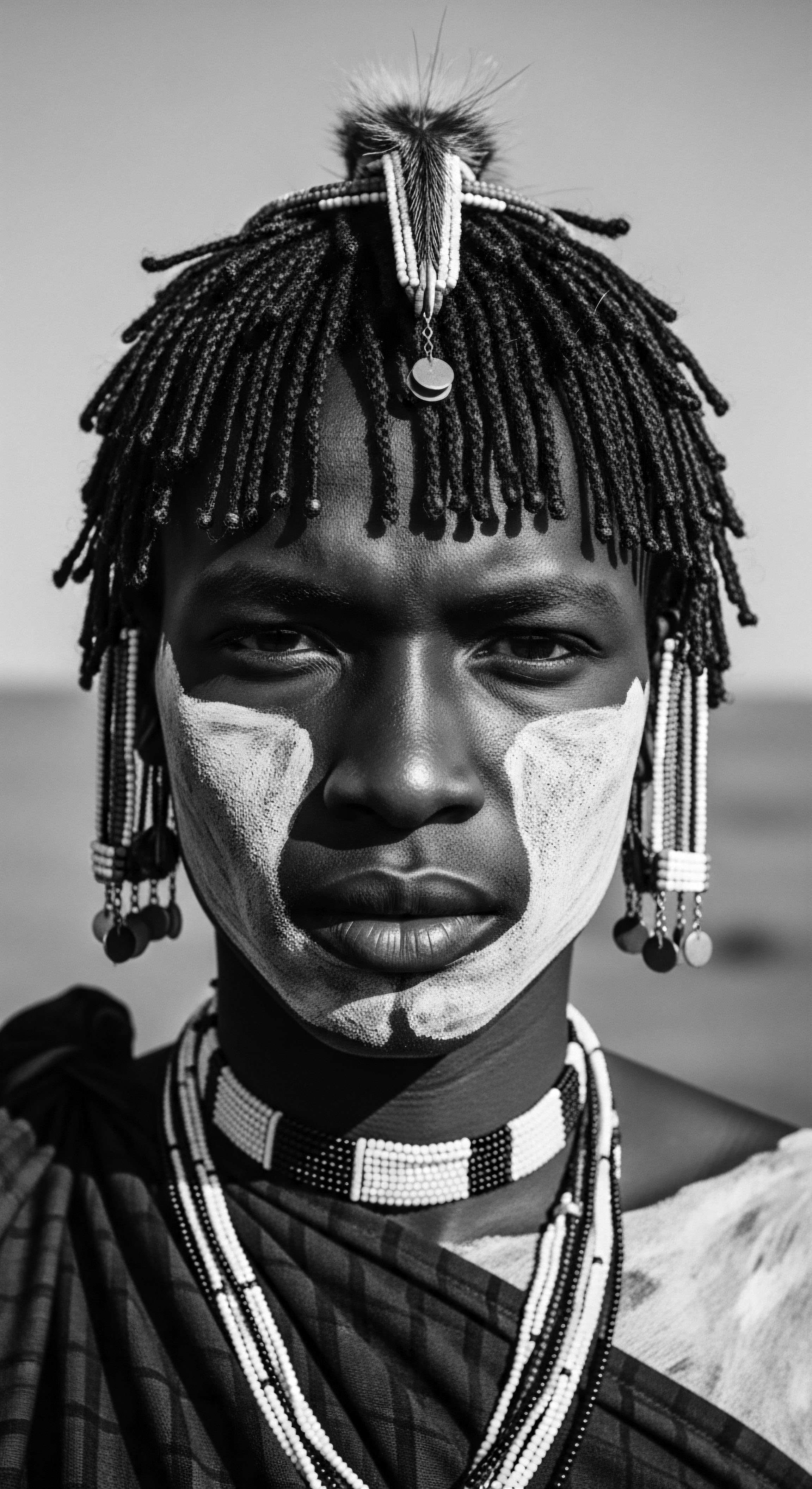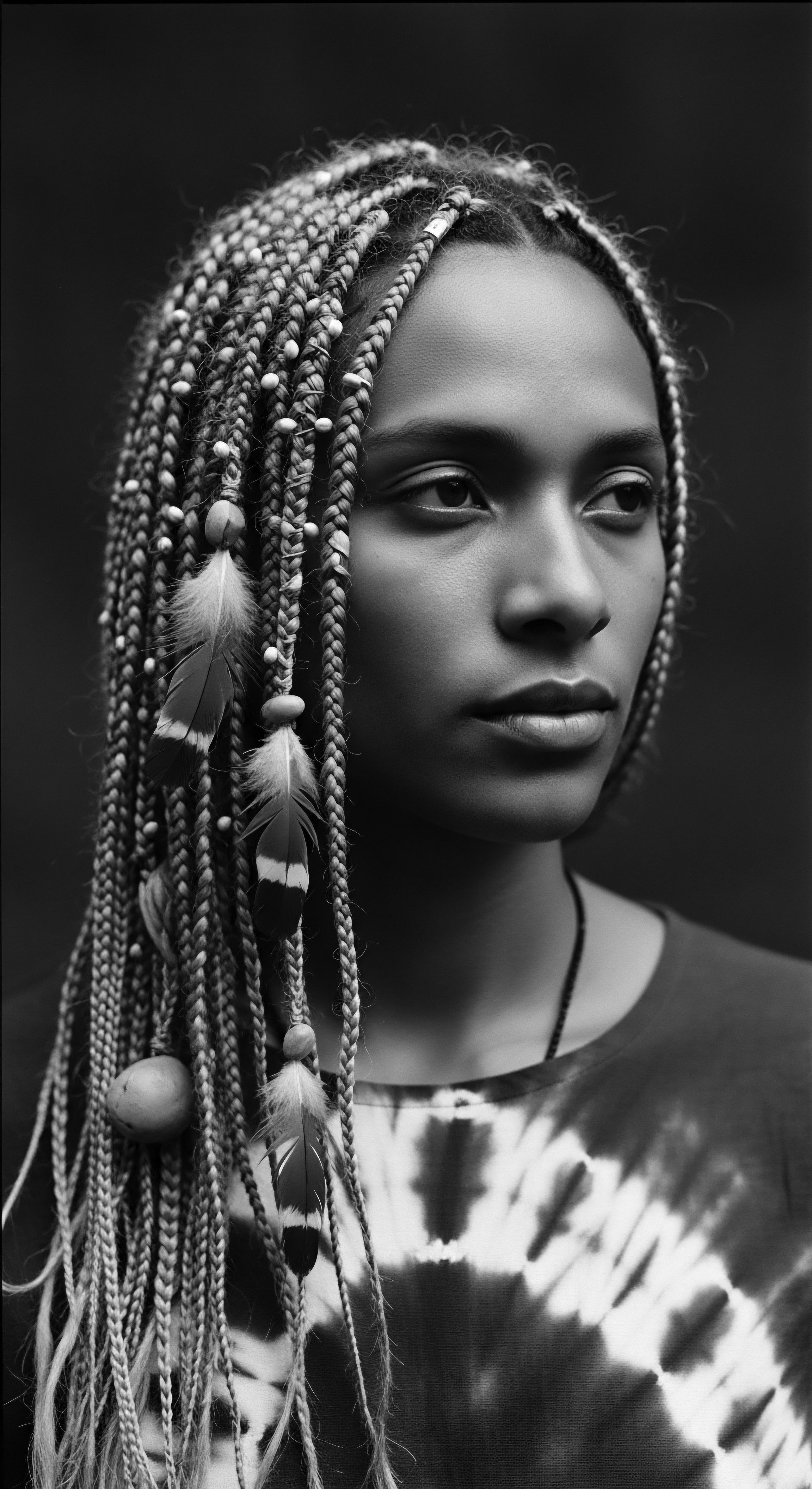
Fundamentals
African American Cosmetology stands as a unique and deeply rooted discipline, an art form and science developed within Black and mixed-race communities to address the distinctive needs and cultural expressions of textured hair. It encompasses a vast landscape of practices, products, and philosophies centered on caring for hair types that range from wavy to tightly coiled. The understanding of African American Cosmetology begins with acknowledging its profound connection to ancestral knowledge, a wisdom passed down through generations. This discipline is not merely about styling hair; it is a holistic approach to wellbeing, a celebration of identity, and a testament to resilience.
At its fundamental level, African American Cosmetology explains the intrinsic properties of textured hair, recognizing its varied patterns and structural characteristics. These characteristics, often defined by the oval to flattened shape of the hair follicle, influence how moisture is retained, how products interact with the strands, and how hair responds to manipulation. Such foundational insights, honed through centuries of practical experience and observation, provided the earliest forms of hair care long before formal scientific study. These traditions were born from necessity and ingenuity, often involving the use of natural ingredients harvested from the earth.
The core meaning of African American Cosmetology also encompasses the communal aspect of hair care, a tradition that predates the transatlantic slave trade. Shared moments of braiding and styling hair fostered bonds, transmitting historical narratives, and reinforcing social structures within communities. This communal approach speaks to the profound significance of hair as a social marker, a communicative tool, and a shared heritage.
African American Cosmetology is a discipline rooted in ancestral wisdom, celebrating the unique biology and cultural expression of textured hair within Black and mixed-race communities.

Early Expressions of Care
From the ancient kingdoms of West and West Central Africa—including regions now known as Senegal, Sierra Leone, Ghana, and Nigeria—hair served as a powerful visual language. Intricate styles communicated marital status, age, societal rank, wealth, and ethnic identity. Such elaborate artistry was not merely aesthetic; it held spiritual significance, a belief that hair connected individuals to their ancestors and the divine.
Early African communities employed a variety of tools and natural ingredients to tend to their hair, utilizing materials such as plant fibers, animal hair extensions, and indigenous butters to maintain moisture and sculpt their diverse styles. These practices underscore the long-standing value placed on hair as a living, expressive part of the self.

Tools and Ingredients from the Source
The earliest forms of African American Cosmetology drew heavily from practices cultivated on the African continent. Understanding this historical context helps to clarify why certain methods persist and why specific ingredients remain cherished.
- Combs ❉ More than simple grooming instruments, combs were often carved with symbols and designs that conveyed group identity and spiritual meaning. These tools were crafted with long teeth and rounded tips, specifically designed to untangle and style tightly coiled hair.
- Natural Butters and Oils ❉ Shea butter, palm oil, and various plant-based extracts were fundamental for moisture retention and scalp health. These ingredients provided essential nourishment, mitigating dryness and promoting hair pliability.
- Clays and Pigments ❉ Certain tribes, like the Himba in Namibia, utilized red ochre paste (otjize) not only for its symbolic connection to the land and ancestors but also for its protective qualities against the sun and insects.

Intermediate
Moving beyond its fundamental aspects, African American Cosmetology unfolds into a complex narrative shaped by historical challenges, adaptation, and unwavering innovation. The discipline’s meaning extends to its role as a cultural anchor, particularly following the forced displacement of Africans during the transatlantic slave trade. As enslaved individuals were stripped of their names, families, and customary dress, their hair often became a silent testament to their heritage, even when forcibly shorn.
Amidst unimaginable cruelty, the meticulous care of hair, even with improvised tools and scarce resources, became an act of self-preservation and a profound link to a lost past. The practice of communal hair styling continued, often on Sundays, serving as a vital gathering for enslaved people to reconnect, share stories, and reinforce familial bonds.

Adaptation and Resistance Through Hair
The experience of enslavement profoundly altered African hair practices, yet the spirit of cosmetology persisted through adaptation and resistance. The infamous Tignon Law of 1786 in Louisiana, which mandated that women of color cover their hair in public, aimed to suppress their visible identity and social status. However, Black women defied the law’s oppressive intent by transforming plain kerchiefs into elaborate, artful head wraps, adorned with intricate patterns and vibrant colors, thereby reclaiming a symbol of pride and beauty. This act illustrates the inherent resilience woven into the fabric of African American Cosmetology—a continuous bending of societal norms to express identity.
The period after emancipation witnessed the emergence of a burgeoning Black beauty industry, born from the necessity to address the unique hair care needs of African American women, largely ignored by white-owned companies. This era saw the rise of pioneering entrepreneurs who understood both the biological specifics of textured hair and its cultural significance. They created specialized products and systems that provided care, nourishment, and styling options, laying the groundwork for what we now understand as a distinct field of cosmetology.
African American Cosmetology, an act of defiance and cultural continuity, transformed oppressive mandates into expressions of communal identity and ingenious self-care.
The very act of hair care during this tumultuous period was often imbued with deeper meaning. Tools such as eating forks heated on stoves served as makeshift hot combs, and mixtures of lard and lye were employed for straightening hair before commercial products became widely available. These makeshift solutions, though potentially damaging, highlight a fierce desire to maintain personal presentation and adapt to prevailing beauty standards, often influenced by Eurocentric ideals.

Pioneers and the Dawn of an Industry
The early 20th century marked a significant turning point, with Black women at the forefront of establishing a formal African American Cosmetology industry. These innovators did more than create products; they built empires that provided economic opportunities and fostered a sense of community and empowerment.
- Annie Turnbo Malone ❉ Born to formerly enslaved parents, Malone understood the intersection of appearance, social standing, and economic independence for African American women. She founded Poro College, a cosmetics school that not only trained women to care for Black hair but also offered a wide range of products, becoming a significant source of employment for African Americans. Malone’s agents sold her custom products and applied the “Poro system” of scalp cleaning and hair nourishing, a holistic approach to hair wellness.
- Madam C.J. Walker (Sarah Breedlove) ❉ A former agent for Malone, Madam C.J. Walker emerged as a monumental figure. Facing her own hair loss challenges, she developed specialized hair products, including her “Wonderful Hair Grower”. Walker’s business model was revolutionary; she established Lelia College to train “hair culturists” and created a vast network of door-to-door agents, predominantly Black women, who achieved financial autonomy through selling her products. Her enterprise extended beyond mere commerce, fostering racial uplift through personal development and public pride. By the time of her passing in 1919, her company employed approximately 40,000 African American women and men across the US, Central America, and the Caribbean, making her America’s first recognized self-made female millionaire.
- Marjorie Joyner ❉ A student of Madam C.J. Walker, Joyner developed a permanent hair-wave machine, contributing a technical innovation to the evolving field.
These pioneers did not simply invent products; they engineered a societal shift, offering employment and fostering self-worth in a segregated society. Their work exemplifies the depth of African American Cosmetology as a force for economic independence and cultural affirmation.

Academic
African American Cosmetology, in its academic understanding, represents a rigorous scholarly domain encompassing the historical, cultural, biological, and socio-political dimensions of textured hair care within the African diaspora. This is not a superficial collection of styling techniques but a deep, interdisciplinary inquiry into the unique characteristics of Afro-textured hair, the ancestral practices that defined its care, and the evolving beauty standards that have shaped its contemporary expression. It mandates a comprehensive examination of how elemental biology informs specific care regimens, how historical subjugation necessitated innovative resistance through self-presentation, and how modern scientific understanding often validates and expands upon centuries-old wisdom. The academic meaning of African American Cosmetology thus emerges from a confluence of dermatological science, cultural anthropology, economic history, and identity studies, providing a robust framework for its comprehensive elucidation.
The unique helical structure of Afro-textured hair, characterized by its elliptical follicle shape, uneven cuticle distribution, and fewer disulfide bonds compared to other hair types, renders it particularly susceptible to dryness and breakage. This intrinsic biological reality underscores the historical necessity for moisture-retaining practices and gentle manipulation, practices intuitively developed by African ancestors long before modern scientific classification. For instance, the traditional use of rich butters and oils was a pragmatic response to the hair’s propensity for moisture loss, a biological truth now understood through advanced dermatological research.
The careful act of braiding, twisting, and knotting, while serving as expressive styles, also functioned as protective measures, reducing mechanical stress and environmental exposure. This interplay of biological specificity and traditional adaptation forms a core tenet of academic inquiry in African American Cosmetology.
African American Cosmetology is a scholarly domain exploring the biological nuances of textured hair, the cultural resilience embedded in its historical care, and its persistent role in shaping identity.

The Unyielding Strand ❉ Hair as a Vector of Identity and Resistance
The academic study of African American Cosmetology also critically examines hair as a profound vector of identity and resistance against oppressive systems. During the transatlantic slave trade, the deliberate shaving of African hair was a brutal act of dehumanization, a calculated effort to strip individuals of their cultural markers and sever ties to their heritage. Yet, even in such dire circumstances, hair retained its symbolic power.
Enslaved Africans, through the clandestine braiding of rice seeds into their hair for survival, or by using cornrow patterns to create escape maps, transformed a tool of oppression into a means of survival and communication. This historical example reveals how the hair itself became a canvas for silent defiance and enduring cultural memory, a living archive of a people’s struggle and spirit.
The post-slavery era and the subsequent Jim Crow laws continued to impose Eurocentric beauty standards, often marginalizing Afro-textured hair as “unacceptable” or “unprofessional”. This societal pressure led to widespread adoption of straightening methods, including hot combs and chemical relaxers, a trend that persisted for decades. However, this period also saw the rise of pioneering Black cosmetologists, who, while sometimes providing straightening solutions, simultaneously built an infrastructure of Black-owned beauty businesses that provided economic independence and platforms for self-affirmation. They challenged the prevailing notion that Black hair was “bad” by creating products tailored to its specific needs, thereby re-centering the narrative of beauty within the community itself.
A particularly illuminating case study in the academic discourse of African American Cosmetology is the rise of the Natural Hair Movement, which gained significant momentum during the Civil Rights and Black Power movements of the 1960s and 1970s. This period saw a powerful shift from chemical alterations to the widespread embrace of natural hair textures, particularly the Afro. This was not merely a stylistic choice; it was a profound political statement, a rejection of Eurocentric beauty norms, and a visible assertion of Black identity and pride.
As Angela Davis, a prominent activist of the era, described, the Afro was a defiant act of “taking up space,” a physical manifestation of a refusal to assimilate. The movement’s impact was quantifiable in both cultural and economic terms ❉ it reshaped perceptions of beauty, fostered a sense of collective identity, and spurred the development of a new segment of the beauty industry focused on natural hair care.
This historical shift finds its echo in contemporary legal battles, such as the CROWN Act in the United States, which seeks to outlaw discrimination based on hair texture or protective styles. The continued need for such legislation underscores the persistent societal biases against natural Black hair, making the academic exploration of African American Cosmetology a matter of ongoing social justice and equity. Research by Johnson and Bankhead (2014) highlights that for both African men and women, hair is intricately connected to cultural identity, spirituality, and character, indicating that denying rights based on natural Black hairstyles constitutes racism. This interweaving of historical precedent, biological understanding, and socio-political struggle defines the rich tapestry of African American Cosmetology as an academic field.

The Biology of Textured Hair ❉ A Scientific Interlude
Understanding the unique characteristics of Afro-textured hair forms a scientific cornerstone of African American Cosmetology. The insights gained from studying the specific morphology of hair follicles and strands provide a basis for effective care.
| Characteristic Follicle Shape |
| Description and Implications for Care Afro-textured hair emerges from an elliptical or ribbon-like follicle, which causes the hair strand to grow in a tight, helical curl pattern. This shape contributes to the hair's coily appearance and its tendency to be less uniform in diameter along its length. |
| Characteristic Cuticle Layer |
| Description and Implications for Care The cuticle, the outermost protective layer of the hair, tends to be less densely packed and may have unevenly raised scales in textured hair. This structural difference can make the hair more prone to tangling, snagging, and moisture loss, requiring specific conditioning approaches. |
| Characteristic Disulfide Bonds |
| Description and Implications for Care Though often appearing robust, Afro-textured hair can have fewer disulfide bonds, which contribute to hair strength and elasticity. This can make the hair more fragile and susceptible to breakage, necessitating gentle handling and protective styling. |
| Characteristic Moisture Retention |
| Description and Implications for Care The tight curl pattern and cuticle structure can impede the natural oils (sebum) from traveling down the hair shaft effectively. This leads to increased dryness, a fundamental consideration for product formulation and application in African American Cosmetology. |
| Characteristic These biological particularities necessitate care regimens that prioritize moisture, minimize manipulation, and protect the delicate structure of textured hair, often validating ancient African practices. |
The biological insights explain why traditional methods like hair oiling and protective braiding, passed down through generations, remain highly effective and are increasingly validated by modern scientific understanding. The goal is not to alter the hair’s inherent structure but to nourish and fortify it in its natural state.

Educational Institutions and the Professionalization of African American Cosmetology
The establishment of formal cosmetology schools, particularly those founded by and for African Americans, represents another crucial academic and practical dimension of this discipline. These institutions moved beyond informal apprenticeships, offering structured curricula that encompassed both technical skills and business acumen.
Historically, educational opportunities for Black women were limited, with cosmetology offering a rare pathway to economic independence and professional status. Schools like Madam C.J. Walker’s Lelia College and Annie Malone’s Poro College became centers of learning, community, and social uplift. They provided rigorous training in hair care, styling, and product application, tailored specifically for textured hair, a curriculum often absent in mainstream beauty schools.
These schools also served as vital community hubs, offering a space for Black people to gather and organize when denied access to public spaces. The curriculum extended beyond mere technical instruction, often embedding lessons on racial pride, self-worth, and entrepreneurial spirit, positioning cosmetology as a vehicle for community building and empowerment. The ongoing emergence of Black-owned cosmetology schools in contemporary society continues this legacy, with institutions like Chanell Ardor Schools of Beauty and Culture focusing on teaching students to work confidently with diverse hair textures, promoting an inclusive atmosphere within the beauty industry. This sustained focus on specialized education underscores the academic depth and practical application within African American Cosmetology.

Reflection on the Heritage of African American Cosmetology
The exploration of African American Cosmetology is a profound meditation on textured hair, its heritage, and its care, presented as a living, breathing archive. From the elemental biology that shapes each helix to the communal practices that weave through centuries, this discipline stands as a testament to ingenuity, perseverance, and an enduring spirit. The journey from ancient African rituals, where hair conveyed wisdom and status, to the forced adaptations of enslavement, and then to the entrepreneurial resurgence of the 20th century, illustrates a continuous, unbroken thread of care and identity.
The tender thread of communal care, historically found in Sunday gatherings and shared styling sessions, continues to connect generations, reminding us that hair care is often an act of love and cultural transmission. This ancestral wisdom, validated by modern science’s understanding of textured hair’s unique structural needs, speaks to a holistic approach where inner wellbeing and external presentation are inextricably linked. The African American cosmetologist, in this light, becomes a custodian of heritage, a healer of self, and a scientist of the strand, capable of nurturing the physical hair while honoring its deep, resonant past.
The unbound helix, in its resilience and infinite capacity for expression, remains a powerful voice. It tells stories of struggle, triumph, and cultural pride. The continuing fight for hair acceptance in mainstream society underscores the ongoing significance of African American Cosmetology not merely as a beauty industry, but as a movement.
It is a movement that insists on the recognition and reverence for every curl, coil, and wave, asserting that the inherent beauty of Black and mixed-race hair is a birthright, a source of power, and a legacy to be cherished. As we look to the future, the lessons learned from the past—the innovation born of necessity, the strength found in communal bonds, and the unwavering assertion of identity—will undoubtedly continue to shape and define the vibrant landscape of African American Cosmetology.

References
- Byrd, Ayana D. and Lori L. Tharps. Hair Story ❉ Untangling the Roots of Black Hair in America. St. Martin’s Publishing, 2001.
- Campbell, Barbara. “Melba? She’s the toast of the town.” The New York Times, 18 Feb. 1973.
- Coleman, A. “The History and Cultural Significance of African Hair Braiding.” Elom African Braids, 21 Dec. 2023.
- Hill, D. “Rhetoric of Natural Hair ❉ Cultural Contradictions.” Advances in Applied Sociology, vol. 14, 2024, pp. 504-516.
- Johnson, D. and Bankhead, T. “The Importance of Hair in the Identity of Black People.” Érudit, 2014.
- Khamit Kinks. “Hair Culture Interview with Nzinga Foreman-Bey and Folosade Bey Al-Rasul.” Occupational Folklife Project, Library of Congress, 2010s.
- Lindsay-Dennis, LaShawnda. “Black Feminist-Womanist Research Paradigm ❉ Toward a Culturally Relevant Research Model Focused on African American Girls.” Journal of Black Studies, vol. 46, no. 5, 2015, pp. 506-520.
- Malone, Annie Turnbo. “Poro College.” National Museum of African American History & Culture.
- Mbilishaka, Crystal, et al. “Dermatologic Issues in African American Hair.” Journal of Clinical and Aesthetic Dermatology, vol. 13, no. 11, 2020, pp. 28-36.
- Rooks, Noli. Hair Raising ❉ Beauty, Culture, and African American Women. Rutgers University Press, 1996.
- Tharps, Lori L. and Ayana Byrd. Hair Story ❉ Untangling the Roots of Black Hair in America. St. Martin’s Press, 2001.
- Walker, Madam C.J. On Her Own ❉ The Life and Times of Madam C.J. Walker.
